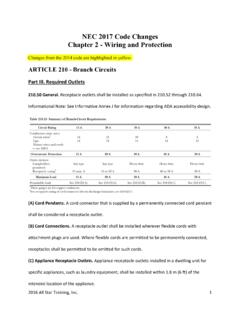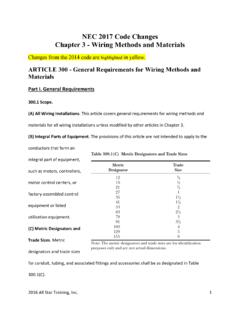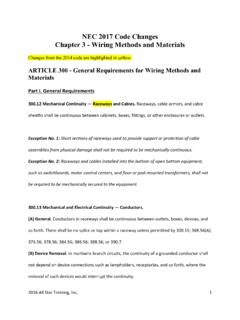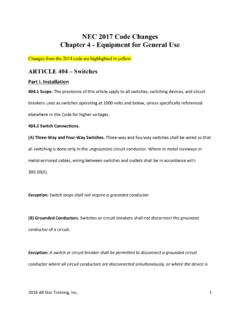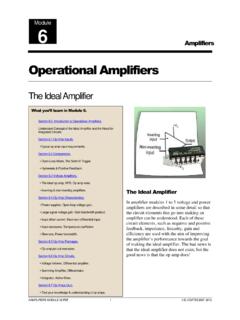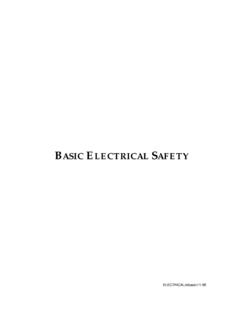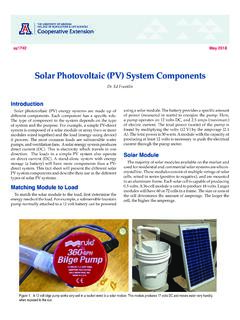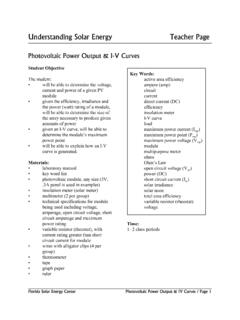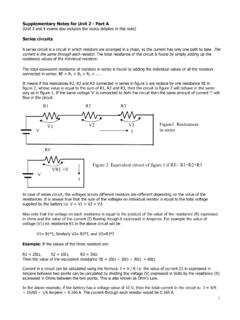Transcription of ARTICLE 690 - Solar Photovoltaic (PV) Systems
1 2016 All Star Training, Inc. 1 NEC 2017 Code Changes Chapter 6 Special Equipment Changes from the 2014 code are highlighted in yellow. ARTICLE 690 - Solar Photovoltaic (PV) Systems Part III. Disconnecting Means Disconnection of Photovoltaic Equipment. Isolating devices shall be provided to isolate PV modules, ac PV modules, fuses, dc-to-dc converters inverters, and charge controllers from all conductors that are not solidly grounded. An equipment disconnecting means or a PV system disconnecting means shall be permitted in place of an isolating device. Where the maximum circuit current is greater than 30 amperes for the output circuit of a dc combiner or the input circuit of a charge controller or inverter, an equipment disconnecting means shall be provided for isolation.
2 Where a charge controller or inverter has multiple input circuits, a single equipment disconnecting means shall be permitted to isolate the equipment from the input circuits. Informational Note: The purpose of these isolating devices are for the safe and convenient replacement or service of specific PV system equipment without exposure to energized conductors. (A) Location. Isolating devices or equipment disconnecting means shall be installed in circuits connected to equipment at a location within the equipment, or within sight and within 3 m (10 ft) of the equipment. An equipment disconnecting means shall be permitted to be remote from 2016 All Star Training, Inc.
3 2 the equipment where the equipment disconnecting means can be remotely operated from within 3 m (10 ft) of the equipment. B) Interrupting Rating. An equipment disconnecting means shall have an interrupting rating sufficient for the maximum short- circuit current and voltage that is available at the terminals of the equipment. An isolating device shall not be required to have an interrupting rating. (C) Isolating Device. An isolating device shall not be required to simultaneously disconnect all current -carrying conductors of a circuit . The isolating device shall be one of the following: (1) A connector meeting the requirements of and listed and identified for use with specific equipment (2) A finger safe fuse holder (3) An isolating switch that requires a tool to open (4) An isolating device listed for the intended application An isolating device shall be rated to open the maximum circuit current under load or be marked Do Not Disconnect Under Load or Not for current Interrupting.
4 (D) Equipment Disconnecting Means. An equipment disconnecting means shall simultaneously disconnect all current carrying conductors that are not solidly grounded of the circuit to which it is connected. An equipment disconnecting means shall be externally operable without exposing the operator to contact with energized parts, shall indicate whether in the open (off) or closed (on) position, and shall be lockable in accordance with An equipment disconnecting means shall be one of the following devices: (1) A manually operable switch or circuit breaker 2016 All Star Training, Inc.
5 3 (2) A connector meeting the requirements of (E)(1) (3) A load break fused pull out switch (4) A remote-controlled circuit breaker that is operable locally and opens automatically when control power is interrupted For equipment disconnecting means, other than those complying with , where the line and load terminals can be energized in the open position, the device shall be marked in accordance with the warning in (B). Part IV. Wiring Methods Methods Permitted. (A) Wiring Systems . All raceway and cable wiring methods included in this Code, other wiring Systems and fittings specifically listed for use on PV arrays, and wiring as part of a listed system shall be permitted.
6 Where wiring devices with integral enclosures are used, sufficient length of cable shall be provided to facilitate replacement. Where PV source and output circuits operating at voltages greater than 30 volts are installed in readily accessible locations, circuit conductors shall be guarded or installed in Type MC cable or in raceway. 2016 All Star Training, Inc. 4 For ambient temperatures exceeding 30 C (86 F), conductor ampacities shall be corrected in accordance with Table (A). (B) Identification and Grouping. PV source circuits and PV output circuits shall not be contained in the same raceway, cable tray, cable, outlet box, junction box, or similar fitting as conductors, feeders, branch circuits of other non-PV Systems , or inverter output circuits, unless the conductors of the different Systems are separated by a partition.
7 PV system circuit conductors shall be identified and grouped as required by (B)(1) through (2). The means of identification shall be permitted by separate color coding, marking tape, tagging, or other approved means. 1) Identification. PV system circuit conductors shall be identified at all accessible points of termination, connection, and splices. The means of identification shall be permitted by separate color coding, marking tape, tagging, or other approved means. Only solidly grounded PV system circuit conductors, in accordance with (A)(5), shall be marked in accordance with 2016 All Star Training, Inc.
8 5 Exception: Where the identification of the conductors is evident by spacing or arrangement, further identification shall not be required. (2) Grouping. Where the conductors of more than one PV system occupy the same junction box or raceway with a removable cover(s), the ac and dc conductors of each system shall be grouped separately by cable ties or similar means at least once and shall then be grouped at intervals not to exceed m (6 ft). Exception: The requirement for grouping shall not apply if the circuit enters from a cable or raceway unique to the circuit that makes the grouping obvious.
9 (C) Single-Conductor Cable. (1) General. Single-conductor cable Type USE-2 and single conductor cable listed and identified as Photovoltaic (PV) wire shall be permitted in exposed outdoor locations in PV source circuits within the PV array. PV wire shall be installed in accordance with (B)(4)(b) and (2) Cable Tray. PV source circuits and PV output circuits using single-conductor cable listed and identified as Photovoltaic (PV) wire of all sizes, with or without a cable tray marking/rating, shall be permitted in cable trays installed in outdoor locations, provided that the cables are supported at intervals not to exceed 300 mm (12 in.)
10 And secured at intervals not to exceed m (4 ft). 2016 All Star Training, Inc. 6 Informational Note: Photovoltaic wire and PV cable have a nonstandard outer diameter. Table 1 of Chapter 9 contains the allowable percent of cross section of conduit and tubing for conductors and cables. (D) Multiconductor Cable. Jacketed multiconductor cable assemblies listed and identified for the application shall be permitted in outdoor locations. The cable shall be secured at intervals not exceeding m (6 ft). (E) Flexible Cords and Cables Connected to Tracking PV Arrays. Flexible cords and flexible cables, where connected to moving parts of tracking PV arrays, shall comply with ARTICLE 400 and shall be of a type identified as a hard service cord or portable power cable; they shall be suitable for extra hard usage, listed for outdoor use, water resistant, and sunlight resistant.
